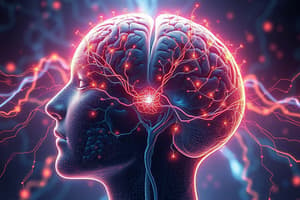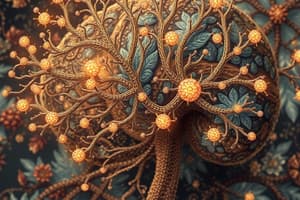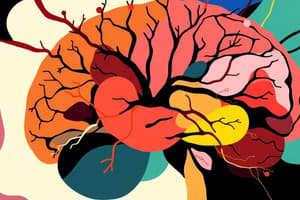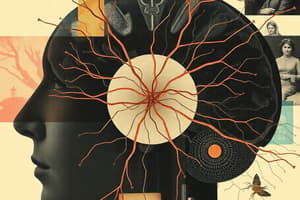Podcast
Questions and Answers
What is the primary function of afferent neurons in the nervous system?
What is the primary function of afferent neurons in the nervous system?
Afferent neurons transmit information to the CNS from sensory receptors.
How do interneurons differ from afferent and efferent neurons in terms of location and function?
How do interneurons differ from afferent and efferent neurons in terms of location and function?
Interneurons are located exclusively in the CNS and transmit information between neurons.
Describe the structural differences between grey matter and white matter in the central nervous system (CNS).
Describe the structural differences between grey matter and white matter in the central nervous system (CNS).
Grey matter contains cell bodies and unmyelinated neurons, whereas white matter consists mainly of myelinated axons.
What are the two major subdivisions of the nervous system?
What are the two major subdivisions of the nervous system?
What is the role of axons in neurons, and what significant structural feature can they possess?
What is the role of axons in neurons, and what significant structural feature can they possess?
How do the nervous system and the endocrine system work together?
How do the nervous system and the endocrine system work together?
List two types of glial cells and their functions within the CNS.
List two types of glial cells and their functions within the CNS.
What role does the nervous system play in responding to environmental stimuli?
What role does the nervous system play in responding to environmental stimuli?
What is the significance of studying neuroscience?
What is the significance of studying neuroscience?
List two specific types of cells found in the adult Central Nervous System.
List two specific types of cells found in the adult Central Nervous System.
What is the role of glial cells in the nervous system, particularly regarding neural stem cells?
What is the role of glial cells in the nervous system, particularly regarding neural stem cells?
Describe the primary function of the enteric nervous system in relation to gut health.
Describe the primary function of the enteric nervous system in relation to gut health.
Explain how astrocytes contribute to the functioning of the blood-brain barrier.
Explain how astrocytes contribute to the functioning of the blood-brain barrier.
What are the components of the peripheral nervous system?
What are the components of the peripheral nervous system?
Discuss the scavenger function of glial cells in the nervous system.
Discuss the scavenger function of glial cells in the nervous system.
Flashcards
What is the central nervous system (CNS)?
What is the central nervous system (CNS)?
The brain and the spinal cord form the central nervous system (CNS) and act as the body's control center.
What is the peripheral nervous system (PNS)?
What is the peripheral nervous system (PNS)?
The peripheral nervous system (PNS) consists of all the nerves outside of the brain and spinal cord.
What is the autonomic nervous system (ANS)?
What is the autonomic nervous system (ANS)?
The autonomic nervous system (ANS) is a subdivision of the PNS responsible for regulating involuntary bodily functions such as heart rate, digestion, and breathing.
What is the somatic nervous system (SNS)?
What is the somatic nervous system (SNS)?
Signup and view all the flashcards
What is the sensory system?
What is the sensory system?
Signup and view all the flashcards
Neuron
Neuron
Signup and view all the flashcards
Dendrites
Dendrites
Signup and view all the flashcards
Axon
Axon
Signup and view all the flashcards
Synapse
Synapse
Signup and view all the flashcards
Afferent Neuron
Afferent Neuron
Signup and view all the flashcards
What is the role of glial cells in buffering ions?
What is the role of glial cells in buffering ions?
Signup and view all the flashcards
How do glial cells help with neurotransmitter removal?
How do glial cells help with neurotransmitter removal?
Signup and view all the flashcards
What is the scavenger function of glial cells?
What is the scavenger function of glial cells?
Signup and view all the flashcards
How do glial cells contribute to the blood-brain barrier?
How do glial cells contribute to the blood-brain barrier?
Signup and view all the flashcards
What role do glial cells play in neuronal development?
What role do glial cells play in neuronal development?
Signup and view all the flashcards
Study Notes
Organisation of the Nervous System & Neurotransmission
- The nervous system coordinates and integrates physiological systems, acting in parallel with the endocrine system (hormonal communication).
- It enables rapid responses to external and internal stimuli (e.g., light, blood pressure), leading to adaptive responses such as reflexes and complex behaviours involving learning and memory.
- Neuroscience is crucial for understanding diseases like neurodegenerative disorders, demyelinating diseases, and mood disorders, as well as viral and bacterial infections of the nervous system.
- Drug companies and funding bodies invest heavily in neuroscience research.
- There's a large, active community of neuroscientists, with large annual meetings drawing thousands of participants.
Functions of the Nervous System
- The nervous system coordinates and integrates multiple physiological systems.
- It works in tandem with the endocrine system (hormonal communication).
- Its role includes rapid responses to external and internal stimuli (e.g., light, blood pressure, osmotic pressure), enabling adaptive responses.
- Nervous system responses can range from simple reflexes to more complex behaviours influenced by learning and memory.
Why Study Neuroscience?
- Studying neuroscience is vital to understand and treat neurodegenerative diseases, demyelinating diseases, and mood disorders impacting the nervous system.
- Viral and bacterial infections of the nervous system are serious concerns that neuroscience research can address.
- Vital physiological functions like appetite, blood pressure, and sleep are controlled by the nervous system.
- Drug companies invest large sums of money in neuroscience research.
- Neuroscience and mental health research have dedicated funding bodies.
- A large community of neuroscientists participates in annual meetings attracting significant numbers of participants.
Outline of Upcoming Lectures
- Lecture 1 will cover the structure and organisation of the nervous system, its cell types, and synaptic neurotransmission.
- Lecture 2 will focus on the modulation of synaptic function, particularly in the autonomic nervous system.
- Lecture 3 will delve into the anatomical and physiological subdivisions of the brain and its key neurotransmitters.
Organisation of the Nervous System
- The nervous system comprises two main divisions: the Central Nervous System (CNS) and the Peripheral Nervous System (PNS).
- The CNS (brain and spinal cord) and the PNS (sensory system, somatic nervous system, autonomic nervous system, sympathetic, parasympathetic and enteric) systems.
- Anatomically distinct, they interact functionally.
Cell Types in the Adult CNS
- The adult CNS contains many cell types: Capillary (-Endothelial cells & Pericytes), Astrocytes, Oligodendrocytes, Neuron, Myelinated axons, Myelin (cut), Microglia, Ependymal cells and Unmyelinated axon.
Anatomy of a Neuron
- Neurons are the fundamental units of the nervous system.
- Their structure typically includes a cell body (soma) containing the nucleus, endoplasmic reticulum (RER), and mitochondria.
- Dendrites are branching extensions from the cell body that receive input from other neurons.
- The axon is a long, slender projection extending from the cell body that transmits signals to other neurons, muscles, or glands.
Neuronal Subtypes
- Sensory (afferent) neurons transmit signals to the CNS.
- Motor (efferent) neurons transmit signals from the CNS to effector organs (muscles/glands) or other neurons.
- Interneurons transmit signals between neurons, primarily found in the CNS.
- Neurons are vital cellular components in the central and peripheral nervous systems.
The Central Nervous System
- The brain and spinal cord constitute the CNS.
- The CNS's input regions receive sensory nerve signals, whilst its output regions control motor nerves and interneurons.
- Grey matter contains neurons, synapses, and glia; white matter contains axons and fibre tracts.
Glial Cells
- Glial cells are crucial for supporting and regulating neuronal function.
- They are far more abundant than neurons in the CNS (10-50 times more).
- Their role includes metabolic support (buffering extracellular ions), removing neurotransmitters, and guiding developing neurons.
Organization of the Peripheral Nervous System
- The PNS comprises the nerves extending from the CNS.
- The PNS includes the sensory system, autonomic nervous system and somatic nervous system.
- Subdivision into sympathetic, parasympathetic, and enteric nervous systems within the autonomic system.
The Enteric Nervous System
- A network of neurons within the gut wall that regulates gut peristalsis, interacts with gut bacteria, and responds to autonomic nervous system activity.
PNS: Cranial Nerves
- There are 12 pairs of cranial nerves emerging from the brain, with various sensory and/or motor functions.
PNS: Spinal Nerves
- Spinal nerves emerge from the spinal cord, with distinct divisions (cervical, thoracic, lumbar, and sacral) distributing signals throughout the body.
The Autonomic Nervous System
- The autonomic nervous system (ANS) regulates involuntary functions like heart rate, smooth muscle contractions, and glandular secretions.
- The sympathetic and parasympathetic divisions work in opposition, often with opposing effects (dual innervation) and roles in regulating the internal environment.
- The sympathetic system responds to stress (fight-or-flight response), while the parasympathetic system conserves resources and promotes homeostasis (rest and digest).
Synapse and Synaptic Transmission
- A synapse is the junction between two neurons where neurotransmission occurs.
- Neuronal communication involves the release and binding of neurotransmitters.
General Anatomy of a Synapse
- A synapse has a presynaptic terminal, synaptic cleft, and postsynaptic terminal, encompassing molecular structures.
3-Dimensional Structure of a Synaptic Bouton
- A typical synapse contains about 60 structural proteins, essential for molecular recognition and function.
Dendritic Arborization
- Dendritic branching is crucial for neuronal function, and highly branched dendrites receive numerous synaptic contacts and contribute to complex interactions.
- Estimates suggest over a hundred trillion synaptic contacts across the CNS (1014).
Neurons in Vitro
- Neurons can be cultured in vitro to study neuronal networks, including interactions, and artificial intelligence research using neurons.
The Neuromuscular Junction
- The NMJ is a specialized synapse between motor neurons and muscle fibres (motor end plate).
- It facilitates rapid signal transmission from motor neurons to muscle fibres.
Synaptic Transmission at the NMJ
- Transmission at the NMJ involves acetylcholine release, receptor binding, and subsequent muscle action potential initiation.
The Myotatic Reflex (Knee Jerk Reflex)
- The myotatic reflex involving sensory neurons signals stretch receptors in muscles.
- Motor neurons responding to signals are central to the myotatic pathway.
EPSPs (Excitatory Post-Synaptic Potentials)
- EPSPs are depolarizing (excitatory) graded potentials at post-synaptic membranes.
- EPSPs can result from increased permeability to Na+ or Ca2+.
IPSPs (Inhibitory Post-Synaptic Potentials)
- IPSPs are hyperpolarizing (inhibitory) graded potentials at post-synaptic membranes.
- IPSPs can result from increased permeability to Cl− or K+.
Synaptic Integration
- Synaptic integration involves the summation of EPSPs and IPSPs to generate a post-synaptic response.
- Spatial and temporal summation contribute to the final outcome determining if it reaches threshold.
Neurotransmitters - Definition
- Neurotransmitters are chemical messengers released by neurons.
- To be considered a neurotransmitter, a substance must meet 4 criteria: synthesis in neurons; presence and release in sufficient amounts to affect post-synaptic cells; exogenous application mimicking endogenously-released transmitter effects; specific mechanism to remove transmitter from the synaptic cleft.
Common Neurotransmitters
- Many neurotransmitters include amines (acetylcholine, norepinephrine), amino acids (glutamate, GABA), and other molecules such as ATP or gases.
Reading Materials
- A range of books and resources for studying human physiology and neuroscience are recommended.
- Online sources are advised for primary articles and reviews.
Studying That Suits You
Use AI to generate personalized quizzes and flashcards to suit your learning preferences.




